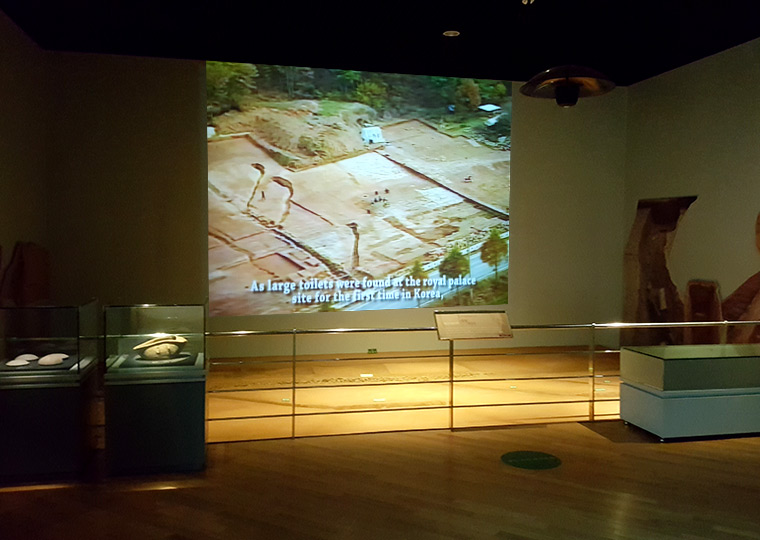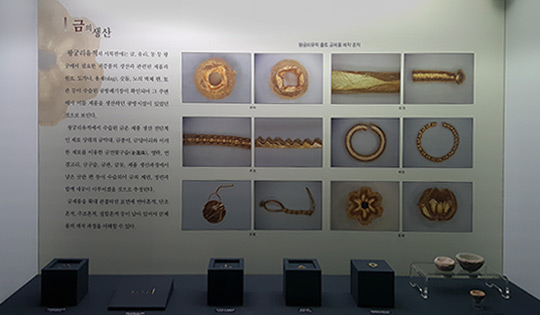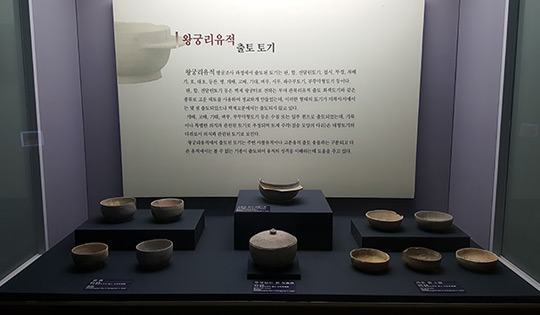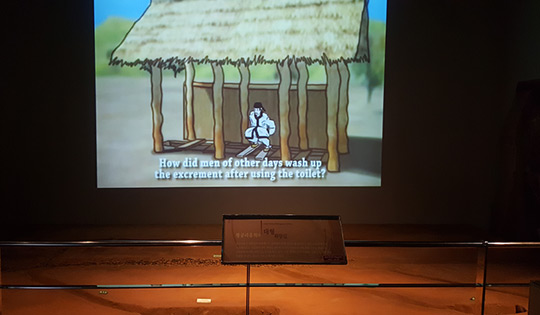Life in Royal Palace
The Wanggung-ri Site Museum is configured in five themes. Viewing the exhibitions in sequence is recommended.
Select any exhibition hall in Wanggung-ri Site Museum and the details regarding the exhibition hall are displayed.

③ Life in Royal Palace
- Production of Gold
- The damp site of craft workshop was identified on the northeastern part of Archaeological Site in Wanggung-ri where the valuables for the royal palace including gold, glass or bronze were produced and relevant items and raw materials, kilns, slag, whetstones and clay pipes were collected. It seems that there was a nearby craft workshop producing those items.
- The kinds of gold collected in the Archaeological Site in Wanggung-ri include gold bar, which was the material for producing gold items, gold nuggets, gold lotus beads made with melt gold, spangles, rings, gold beads, gold plates, gold nails, as well as gold scraps left during the production process. Accordingly, it is estimated that gold refining and tempering and gold work may have been done in this site.
- When the surface of a gold item is zoomed into for observation, traces of grinding, forging, molding or joining are found on the surface. It helps in the understanding of the process of producing gold items.

- Production of Glass
- Glass beads or glass pieces, the glass items collected in the Archaeological Site in Wanggung-ri, tools including kilns, ventilation fans and molds used for producing glass, quartz which is the material for producing glass and whetstone used for processing glass indicate the production of glass during Baekje period.
- Traces of glass production and gold and bronze items were found on the northeast side of the Archaeological Site in Wanggung-ri, the lower story of the auditorium site and the middle of the 4th east-west stonework. This indicates that glass was refined and processed there. Green, yellow, red and black hyalin was found on the inner and outer surface of the glass kiln, indicating that glass was manufactured in a variety of colors through the use of pigments in the glass production process. Glass beads, glass pieces of a container like a jar and sheet glass about 1cm thick have been found in the Archaeological Site in Wanggung-ri.
- Analysis of the ingredients of those glass items shows that alkali glass, which was not found at the Baekje historic site in Iksan, as well as lead glass was utilized. In accordance with a comparison of the lead glass found in the Archaeological Site in Wanggung-ri and Mireuksa temple site, the colors, ingredients and lead isotope ratio were identical and therefore it is estimated that the lead glass was produced in the same workshop.
- Earthenware in the Archaeological Site in Wanggung-ri
- The earthenware found on the Archaeological Site in Wanggung-ri during excavation includes small bowls, bowls with covers, eared bowls, plates, lids, round and large bowls, jars, large jars, lamps, bottles, mounted bowl, covered cups, stands, inkstone, steamers, stove hearth-type earthenware and open pedestal type earthenware. Small bowls, bowls with covers and eared bowls are the same type as the gray earthenware found in Gwanbuk-ri historic site in Buyeo, which was said to be the Baekje royal palace site. They were elaborately created using fine clay. While several earthenware pieces in those shapes were found on the Mireuksa temple site, they were not found in the Baekje tombs nearby.
- The incised lines were found on the rim of the small bowl and the rim of the lid to indicate that the small bowl and the lid were the set in the earthenware molding process. Those earthenware were found only in the historic sites related to Seodong or King Mu including the Seodong birthplace site, Iksan twin tombs and Sindong-ri historic site in Iksan. Several mounted bowls, covered cups, stands, inkstones, and stove hearth-type earthenware were found as whole items or as pieces. It is estimated that they were related to special rituals or records. The animal-shaped leg of earthenware was for large earthenware pieces. Both sides of the animal-shaped leg were pressed to make the leg narrow. The earthenware found in the Archaeological Site in Wanggung-ri is easily classified by its technology or clay from other artifacts found in ancient tombs or temple sites around. The earthenware found in the Archaeological Site in Wanggung-ri helps to understand the Baekje royal palace because of the types which were not found at other historic sitess.

- Historic Garden Site
- The garden in the Archaeological Site in Wanggung-ri is related to the relaxation or ancestral rites of a king along with the back garden. It occupies half of the northern section in the Baekje royal palace except for the craft workshop site. The historic garden site in the Baekje royal palace is mainly in the eastern section of the 4th east-west stonework area where the back garden began. The center of the garden, water tank facility, drainage facility, water collection facility, footway and pavilion site were found. The fantastic rocks were arranged or laid on the center of the garden and the rectangular stones were arranged in channel shape in front of the garden. The river gravels were laid inside to control the flow of water. Unlike the traditional garden of Baekje, the miniature landscape was made by scaling down the surrounding scenery with the fantastic rocks and the garden in the new shape was created by connecting the pond in front of the miniature landscape.
- The large water tank that is 47.5m long from east to west and 2.96m long from south to north was made with the flagstones and sage-green clay to the west from the center of the garden and supplies water to the garden. Furthermore, the receiving reservoir collecting water flowing out of the garden was found on the southeastern part and the footway and pavilion site were found on the eastern part of the garden. A U-shaped waterway, sinuous canal, and pavilion building of 4 Kans from east to west and from south to north each were found on the northern part from the center of the garden and the back garden. The U-shaped waterway starts from the northeastern hill from the center of the garden, goes up along the east boundary wall, curves in front of the entrance on the north, and goes downward along the western hill toward the south. So the overall shape of the waterway is U shape. The U-shaped waterway was made by digging a cross section of the hillside in a reversed trapezoid shape and some sections were made by piling up paving stones, trimmed stones or natural stones.
- The landscape stones or natural stones were placed upright inside the waterway and pebbles or river gravel was laid on the floor in some sections. It appears that the U-shaped waterway was also used as the garden. It is estimated that the U-shaped waterway was made for collecting or draining water or as landscaping to supply water to surrounding facilities including inside the royal palace or garden. The sinuous canal was made by digging a cross section of the red clay layer, the soil layer, in a V, U or reversed trapezoid shape. It was named the sinuous canal because of its winding shape. Two sinuous canals running from north to south were found on the left and right side on the western part of the U-shaped waterway. Three waterways connecting both sinuous canals and an east-to-west waterway in the southern section of the back garden were also found. The total length of the waterways was 685.3m.
- It appears that water flow was determined depending on the height of the embankment and water quantity because the bottom of the sinuous canal was rugged and the direction of slope was not constant. As it was found that the sinuous canal was made after demolishing a U-shaped waterway during excavation, it appeared that the sinuous canal was made after the U-shaped waterway. While the purposes of the sinuous canals were to distribute water flow to maintain or supply water, it has been estimated that there was probably another purpose as well, since the sinuous canal on the upper area and that on the lower area were connected each other and the depth even in one sinuous canal was different.
- The rectangular building site with stylobate that was 4 Kans in front and on each side (Building Site 36) was found in the center of the U-shaped waterway. Seven circular stylobate were found in the south-north direction, which was estimated as the corridor-style building site on the western part of the rectangular building site above. The central axis of the rectangular building site is on the same line as that of the north gate side. It is on the center of the back garden, 40m above sea level, which was the highest level in the Baekje royal palace. The corridor surrounded the building. It appears that it was a pavilion-shaped building to perform banquets or rituals as it was placed at a higher level than other buildings.
- Craft Workshop Site
- The midden site for the craft workshop, burnt clay site and midden site for burnt clay were found on the northeastern part of the Archaeological Site in Wanggung-ri, where kilns, slag, whetstones, wall pieces and stones related to glass, gold and bronze were found in quantity. The presence of the craft workshop to supply valuables in the royal palace was confirmed.
- Baekje Restroom Culture
- The restroom site was analyzed in 2003. A pit that was 10.8m long from east to west, 1.7~1.8m long from south to north and 3.4m deep, was divided by driving a wooden pole into it to allow several people to use the restroom at once. During the process of examining the depth in the center of the restroom site, chestnut shells, oriental melon seeds and beans were found so it was initially thought that the pit had been a storage area. However, when digging deeper, odor was noticed. Soil was collected and observed under microscope, which found parasitic eggs, including roundworm eggs, whipworm eggs and liver fluke eggs.
- Six wood sticks used for cleaning like toilet paper were found on the bottom, indicating that the site was a restroom not storage. Even though the restroom site was found on the northeastern part of Baekje royal palace, it is not considered that the king or royal family came here to use the toile. Two toilet bowl-shaped earthenware pots (Korean chamber pots) were found on the drain in the east-west stonework on the north of the restroom site. It seems that the king and royal family relieved themselves in the toilet bowl-shaped earthenware, the portable toilet bowl in the royal palace, and that these chamber pots were then emptied into the restroom site.
- In this process, the chamber pots would be buried in the drain on the east-west stonework. Three restroom sites were found in the Baekje royal palace. When two-thirds of the clay chamber pot was filled, the contents were emptied out of the western boundary wall through the drain. Thus, the correlation with the restroom in Japan must be examined. The restroom site in the Baekje royal palace is the oldest one in Korea. It appears to have been a hygienic solution to human waste.



